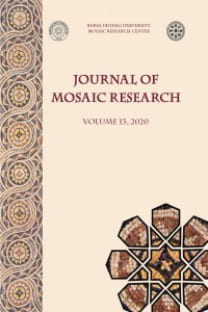Bir Geometrik Mozaik Dekorunun Doğru Bir Şekilde Belirlenmesi Gereği Üzerine Bir Vaka Çalışması
Tipoloji, geometrik mozaik, model, kontrol, restitüsyon
De la nécessité d’identifier précisément le décor géométrique d’une mosaïque. Une étude de cas
Typology, geometric mosaic, model, check, restitution,
___
- Alberti 2013 M. Alberti, La créativité en mathématiques. Fonctionnement d’un esprit d’exception. Paris. Blanco Freijeiro 1978 A. Blanco Freijeiro, Mosaicos romanos de Itálica (I). Madrid, Instituto español de arqueologia «Rodrigo Caro».
- Décor I C. Balmelle – M. Blanchard Lemée – J. Christophe – J. P. Darmon – A. M. Guimier Sorbets – H. Lavagne – R. Prudhomme – H. Stern, Le Décor Géométrique de la Mosaïque Romaine I, Paris, Picard, 1985.
- Décor II C. Balmelle – M. Blanchard Lemée – J. P. Darmon – S. Gozlan – M. P. Raynaud, Le Décor Géométrique De La Mosaïque Romaine II, Paris, Picard, 2002.
- Gisler - Huwiler 1984 J.-R. Gisler – M. Huwiler, “La Maison aux Pilastres”, J. Balty (ed.), Apamée de Syrie. Bilan des recherches 1973-1979, 79-106. Bruxelles, Centre belge de Recherches archéologiques à Apamée de Syrie.
- Hanoune 1994 R. Hanoune, “Le travail de l’ouvrier mosaïste à Bulla Regia (Tunisie)”, La mosaïque gréco-romaine IV, 281-283.
- Lancha – Oliveira 2013 J. Lancha – C. Oliveira, Corpus dos mosaicos romanos de Portugal, Algarve Este. Faro, Universidade de Algarve.
- Lavagne – Tenu 1985 H. Lavagne – R. Tenu, “La Grange-du-Bief à Anse (Rhône) : nouvelles recherches et mosaïques inédites”, Gallia 43, 147-166.
- Levi 1971 D. Levi, Antioch Mosaic Pavements, Roma.
- Parzysz 2009 B. Parzysz, “Key diagrams to Design and Construct Roman Geometric Mosaics?”, Nexus Network Journal 11/2, 273-288.
- Parzysz 2011 B. Parzysz, “Une grande famille de décors géométriques”, M. Şahin, (ed.), Actes du 11e Colloque de l’AIEMA, 735-747.
- Salies 1974 G. Salies, “Untersuchungen zu den geometrischen Gliederungsschemata römischer Mosaiken”, BJb 174, 1-178.
- Tebby 1995 S. Tebby, “Geometric Mosaics of Roman Britain”, P. Johnson, R. Ling, D.J. Smith (eds.), Proceedings of the 5th Colloquium on Ancient Mosaics, 273-294.
- ISSN: 1309-047X
- Yayın Aralığı: 1
- Başlangıç: 2008
- Yayıncı: Ululdağ Üniversitesi, Mozaik Araştırlmaları Merkezi
Terrazzo, Harç ve Beton Kaplama: Sorunsal Durum
Metropolis Mask Mozaiğinin Geometrik Çözümlemesi
Opus Signinum, Terrazzo, Harç ve Beton Kaplama: Sorunsal Durum
Nissma BOUZOUBAA, Abdelilah DEKAYİR
Kuzey Suriye'de Bulunan Mezar Mozaiği
Bir Geometrik Mozaik Dekorunun Doğru Bir Şekilde Belirlenmesi Gereği Üzerine Bir Vaka Çalışması
Apollonia’daki (Arnavutluk) Athena Domus’u: Yeniden Değerlendirme
